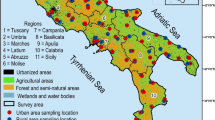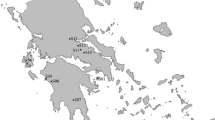Abstract
Fifty-six representative samples of topsoil were collected around Guanting Reservoir, which is an important water source for Beijing. Concentrations of the insecticides HCH, DDT, and their metabolites were quantified by use of gas chromatography (GC) with electron capture detection (ECD). Organochlorine pesticides (OCPs) are still present in surface soils in the Guanting area. DDT accounts for about 93% of the total OCP content. Concentrations of α/γ, β/γ, and DDT/DDE are the result not only of historical use, but also of more recent depositions. Statistical analyses, including principal component analysis (PCA) and cluster analysis (CA), revealed associations between concentrations of OCPs and major soil characteristics. Geographical information system (GIS) technology was used to develop maps of the distributions of OCP concentrations. The areas of greatest contamination were primarily in the central part of the study area and were correlated with greater population density, heavier traffic, and more industrial activity.





Similar content being viewed by others
References
Allen-Gil, S. M., Gubala, C. P., Wilson, R., Landers, D. H., Wade, T. L., & Sericano, J. L. (1997). Organochlorine pesticides and polychlorinated biphenyls (PCBs) in sediments and biota from four US Arctic Lakes. Archives of Environmental Contamination and Toxicology, 33, 378–387.
Colborn, T., & Smolen, M. J. (1996). Epidemiological analysis of persistent organochlorine contaminations in cetaceans. Reviews of Environmental Contamination and Toxicology, 146, 91–172.
Cousins, I. T., Bondi, G., & Jones, K. C. (1999). Measuring and modeling the vertical distribution of semivolatile organic compounds in soils. I: PCH and PAH soil core data. Chemosphere, 39, 2507–2518.
Environmental Standard Committee of China. (1995). Compilation of China environmental protection standards (1989–1994). Beijing: China Standard Publishing House.
Fillmann, G., Readman, J. W., Tolosa, I., Bartocci, J., Villeneuve, J. P., Cattini, C., & Mee, L. D. (2002). Persistent organochlorine residues in sediments from Black Sea. Marine Pollution Bulletin, 44, 122–133.
Hao, F. H., Sun, F., & Zhang, J. Y. (2002). Progress of studies on the nonpoint source pollution in the Guanting Reservoir. Earth Science Frontiers, 9, 385–386.
Hitch, R. K., & Day, H. R. (1992). Unusual persistence of DDT in some western USA soils. Bulletin of Environmental Contamination Toxicology, 48, 259–264.
Hua, X. M., & Shan, Z. J. (1996). The production and application of pesticides and factor analysis of their pollution in environment in China. Advance of Environmental Science, 44, 33–45.
Iwata, H., Tanabe, S., Sakai, N., Nishimura, A., & Tatsukawa, R. (1994). Geographical distributions of persistent organochlorines in air, water and sediments from Asia and Oceania and their implications for global redistribution from lower latitudes. Environmental Pollution, 85, 15–33.
Jones, K. C., & Voogt, P. D. (1999). Persistent organic pollutants (POPs): State of the sciences. Environmental Pollution, 100, 209–221.
Kim, S. K., Oh, J. R., Shim, W. J., Lee, D. H., Yim, U. H., Hong, S. H., Shin Y. B., & Lee D. S. (2002). Geographical distribution and accumulation features of organochlorine residues in bivalves from coastal areas of South Korea. Marine Pollution Bulletin, 45, 268–279.
Kim, J. H., & Smith, A. (2001). Distribution of organochlorine pesticides in soils from South Korea. Chemosphere, 43, 137–140.
Keith, L. H. (1997). Environmental endocrine disruptors. A handbook of property data (pp. 621). New York: Wiley.
Lee, K. T., Tanabe, S., & Koh, C. H. (2001). Distribution of organochlorine pesticides in sediments from Kyeonggi Bay and nearby areas, Korea. Environmental Pollution, 114, 207–213.
Liang, T., Wang, H., & Ding, S. M. (2003). Temporal trend of water quality in Guanting Reservoir in recent 30 years. Progress in Geography, 22, 38–44.
Liu, G. S. (1996). Physico-chemical characteristics of soils and Description for soil profile (pp. 38–42). Beijing: China Standard press.
Ma, M., & Wang, Z. J. (2001). Contamination of PCBs and organochlorinated pesticides in the sediment samples of Guanting Reservoir and Yongding River. Environmental Chemistry, 20, 238–243.
Netherlands Ministry of Housing (NMH). (2000). Spatial planning and the environment. Circular on target values and intervention values for soil remediation. http://www2.minvrom.nl/Docs/internationaal/annexS_I2000.pdf.
Olsen, S. R., & Sommers, L. E. (1982). Phosphorus. In A. L. Page, R. H. Miller, & Keeney D. R. (Eds.), Methods of soil analysis (Part 2). WI: American Society of Agronomy Madison.
Rodan, B. D. (2002). The Foundation for global action on persistent organic pollutants: A United States perspective. Washington, DC: Office of Research and Development.
Smith, R. L. (1996). Ecology and field biology (5th ed.). New York: Harper Collins.
van Wijngaarden, R. P. A., van den Brink, P. J., Oude Voshaar, J. H., & Leeuwangh, P. (1995). Ordination techniques for analyzing the response of biological communities to toxic stress in experimental ecosystems. Ecotoxicology, 4, 61–77.
Wang, L. S. (2004). Chemistry of organic pollution (pp. 801–809). Beijing: Higher Education Press.
Wang, X. T., Chu, S. G., & Xu, X. B. (2003). Organochlorine pesticide residues in water from Guanting Reservoir and Yongding River, China. Bulletin of Environmental Contamination and Toxicology, 70, 351–358.
Wang, T. Y., Lu, Y. L., Dawson, R. W., Shi, Y. J., Zhang, H., & Xing, Y. (2006). Effects of environmental factors on organochlorine pesticide residues in soils of the Guanting Reservoir area, China. Journal of Environmental Science and Health, Prat B, 41, 309–321.
Wang, T. Y., Lu, Y. L., Zhang, H., & Shi, Y. J. (2005). Contamination of persistent organic pollutants (POPs) and relevant management in China. Environment International, 31, 813–821.
Wania, F., & Mackay, D. (1996). Tracking the distribution of persistent organic pollutants. Environmental Science and Technology, 30, 390A–396A.
Wong, M. H. & Poon, B. H. T. (2003). Sources, fates and effects of persistent organic pollutants in China, with emphasis on the Pearl River delta. In The handbook of environmental chemistry Vol. 3, Part 0: Persistent Organic Pollutants (pp. 355–369). Berlin: Springer.
Woodwell, G. M., Craig, P. P., & Johnson, H. A. (1971). DDT in the biosphere: Where does it go? Science, 174, 1101–1107.
Wu, Y., Zhang, J., & Zhou, Q. (1999). Persistent organochlorine residues in sediments from Chinese river/estuary systems. Environmental Pollution, 105, 143–150.
Xue, N. D., Zhang, D. R., & Xu, X. B. (2006). Organochlorinated pesticide multiresidues in surface sediments from Beijing Guanting reservoir. Water Research, 40, 183–194.
Yue, Y. D., Hua, R. M., Zhu, L. Z., Zhu, S. W., & Che, D. D. (1990). Residual status of HCH and DDT in agro-environment of Anhui province. Journal of Anhui Agricultural College, 17, 194–197.
Zhang, Z., Huang, J., Yu, G., & Hong, H. (2004). Occurrence of PAHs, PCBs and organochlorine pesticides in the Tonghui River of Beijing, China. Environmental Pollution, 130, 249–261.
Zhang, H., Lu, Y. L., Dawson, R. W., Shi, Y. J., & Wang, T. Y. (2005). Classification and ordination of DDT and HCH in soil samples from the Guanting Reservoir, China. Chemosphere, 60, 762–769.
Zhang, H. B., Luo, Y. M., Zhao, Q. G., Wong, M. H., & Zhang. G. L. (2006). Residues of organochlorine pesticides in Hong Kong soils. Chemosphere, 63, 633–641.
Acknowledgments
This study was supported by the National Basic Research Program of China (“973” Research Program) with grant no. 2007CB407307 and the Knowledge Innovation Program of the Chinese Academy of Sciences, with grant no. KZCX2-YW-420-5. The authors would like to thank Professor Guibing Jiang and Dr. Ruiqiang Yang from the Research Center for Eco-Environmental Sciences, Chinese Academy of Sciences, for their assistance in conducting the OCP analyses.
Author information
Authors and Affiliations
Corresponding author
Rights and permissions
About this article
Cite this article
Wang, T., Lu, Y., Shi, Y. et al. Organochlorine pesticides in soils around Guanting Reservoir, China. Environ Geochem Health 29, 491–501 (2007). https://doi.org/10.1007/s10653-007-9118-9
Received:
Revised:
Accepted:
Published:
Issue Date:
DOI: https://doi.org/10.1007/s10653-007-9118-9




